|
|
|
Sort Order |
|
|
|
Items / Page
|
|
|
|
|
|
|
| Srl | Item |
| 1 |
ID:
164483
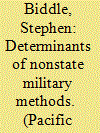

|
|
|
|
|
| Summary/Abstract |
For generations, most analysts treated state and nonstate war making as a dichotomy, with states employing high-intensity ‘conventional’ methods centered on seizing and holding ground, but with nonstate actors using low-intensity ‘irregular’ methods such as roadside bombings, ambushes, and assassinations. This article, by contrast, argues that many nonstate actors have adopted substantially conventional warfighting styles, and that more are likely to do so over time. Increasingly, the best predictor of a combatant’s military methods is not its status as a state as opposed to a nonstate actor, but its internal politics – and especially its institutional maturity and war aims.
|
|
|
|
|
|
|
|
|
|
|
|
|
|
|
|
| 2 |
ID:
164486
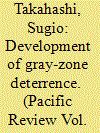

|
|
|
|
|
| Summary/Abstract |
In contemporary international security, some powers try to challenge the status quo through gradual, sub-threshold expansion without resorting to the explicit use of force. Examples of such sub-threshold challenges can be seen in the East China Sea, the South China Sea, and Eastern Europe. They are now referred to as ‘gray zone’ or ‘hybrid threat’. For a long time deterrence theory, a core component of strategic studies, has largely neglected such sub-threshold challenges. The exceptional part of that is empirical school’s findings, including fait accompli, limited probe, and controlled pressure. They perfectly match with the current threats and help developing conceptual framework to deter these kind of threats. Based on these findings, this paper attempted to illustrate three principles for gray zone deterrence: combination of deterrence by denial and deterrence by punishment, mobilization of the whole government assets, and keeping open the window to escalation and analyze, Japan’s efforts to develop conceptual framework for gray zone deterrence. Since Japan’s efforts to develop conceptual framework of gray zone deterrence dates further back than other part of the world, as the National Defense Program Guidelines (NDPG) of 2010, a case study on Japan would provide useful insights for gray zone deterrence.
|
|
|
|
|
|
|
|
|
|
|
|
|
|
|
|
| 3 |
ID:
164482
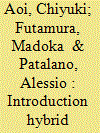

|
|
|
|
|
| Summary/Abstract |
This special issue explores how and to what extent ‘hybridity’ informs national policy, doctrines, and military transformation in Asia. The introduction engages with three preliminary issues as a way to set the broader analytical context. It reviews the concept of ‘hybrid warfare’ to make the case that versions of this notion have long been a feature of regional strategic thinking and practice. It similarly argues that maritime geography has had an impact on how ‘hybrid’ courses of actions in the region have been conceptualised, notably in regards to ‘grey zone’ operations. Lastly, it reviews the question of how to engage with the issue of the effectiveness of such strategies.
|
|
|
|
|
|
|
|
|
|
|
|
|
|
|
|
| 4 |
ID:
164484
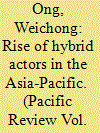

|
|
|
|
|
| Summary/Abstract |
This article examines the manifestation and trends of hybrid warfare in the Asia-Pacific region through the lenses of the following three key hybrid actors: China, North Korea and ISIS affiliates in Southeast Asia. This article explains why the hybrid approach can be such an attractive strategic option for both state and non-state actors in the Asia-Pacific. Finally, this paper will address the impact of how the constant pushing of boundaries in hybrid warfare can lead to unintended consequences.
|
|
|
|
|
|
|
|
|
|
|
|
|
|
|
|
| 5 |
ID:
164485
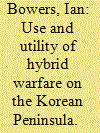

|
|
|
|
|
| Summary/Abstract |
This article uses hybrid warfare as a framework for examining North Korean operations on the Korean Peninsula and the South Korean reaction to such operations. It argues that North Korea has long employed a hybrid approach to achieve a wide number of political and strategic objectives. However, the deterrence-based strategic reality on the Korean Peninsula in combination with North Korea’s increasing relative weaknesses has rendered this approach self-defeating.
|
|
|
|
|
|
|
|
|
|
|
|
|
|
|
|
|
|
|
|
|